It’s been 10 years since I started this blog, originally called “The Attitude Adjustor,” but retitled “The Nowtopian” in 2008 or so. And I just went six weeks without an entry, the longest gap in all these years I think… hmmm. Well, I’ve been quite busy as you can imagine. Spent the past six weeks employed as a curator and writer for a new Tenderloin Museum slated to open in Fall 2014 at the Cadillac Hotel in San Francisco’s Tenderloin. We’ll see how what I wrote turns out after museum designers—and editors unknown—get done with it! I’m guessing it’ll get pretty flattened and drained of some of what I think are the most important histories, but let’s hope for the best.
I’ve been reading a lot during these past months too, and will be writing about two books in particular in this entry. First, my enthusiastic kudos to Jonathan Lethem for Dissident Gardens and Margaret Atwood for the final volume in her trilogy MaddAdam—two novels that I really enjoyed. (I also plowed through Oscar Wilde’s classic Portrait of Dorian Gray but I really didn’t like it, thereby violating my cardinal rule of not finishing anything that I don’t really enjoy.) I mentioned in the past entry how much I loved Gary Kamiya’s Cool Gray City of Love, which went right into my top five of books about San Francisco past and present. (Kamiya also generously and graciously allowed us to use two excerpts on FoundSF, one a great short history of the Western Addition, and the other about searching for evidence of the original inhabitants of San Francisco.) And I just cruised through Ian Buruma’s fascinating Year Zero about 1945. I had that lurking sense that things happened in that year that are still shaping our lives today, and to some extent that is borne out by his book. The assault on labor and the left that began in the waning months of WWII set the stage for so much of the Cold War and the way things evolved in the last half of the 20th century, right up to and including the bizarre ideological zombies parroting all this pro-market gibberish in the wake of the tidal wave of displacement and community destruction underway in San Francisco.
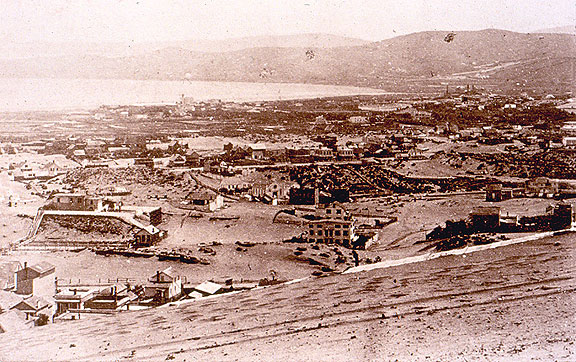
St. Ann’s Valley, 1858, looking south across what would later become the Tenderloin and South of Market towards Mission Bay and Potrero Hill in the distance.
And that leads me to today’s topic which is broadly “liberalism.” Twenty years ago I read Immanuel Wallersten’s After Liberalism, which I thought was a sharp analysis and very cogent explanation for the post-Cold War world. In it he looks at the long trajectory of politics from the French revolution through the 20th century and showed how liberals had come to depend on communism, without which they had trouble explaining what they stood for. As long as there was a totalitarian left the liberals could masquerade convincingly as a humanist left. (It deserves to be mentioned, though, that Jimmy Carter was the first neoliberal president, pushing a deregulatory privatizing agenda even before Reagan came in to accelerate the process—see Jefferson Cowie’s excellent Stayin’ Alive: The Last Days of the American Working Class for a great analysis of this.)
But what we’ve seen during the quarter century since the collapse of the Soviet Union is a similar and perhaps more abject collapse of liberalism. Bill Clinton, still strangely lauded as a liberal Democrat, oversaw the deregulation of the financial industry, the destruction of the welfare state, and strongly pushed free trade (NAFTA and WTO) along with privatization at every turn (Obama has just been more Clintonism, perhaps a bit more aggressively pro-corporate). Tony Blair did the same in England at the head of a “Labor” government. In England of course, as in Europe more generally, “liberal” does not refer to people on the left. (The Economist magazine considers itself a liberal newspaper even though it’s a magazine and one of the most staunchly pro-business rags in the world.) In the United States official politics is divided between the two parties and the two acceptable ideologies, which used to be liberal and conservative, but after 1990 or so, it became moderate and conservative, with the label “liberal” so derided by the right-wing media echo chamber that no mainstream politician would defend it any more. To be sure, many vaguely leftish folks these days still call themselves “liberals” in the U.S. Plenty of the tech “working class”—who are raking it in and dominating the SF real estate market—claim a socially liberal politics while promulgating a harsh libertarian pro-market economic bias, which in terms of classical definitions is purely liberal too. The odd hybrids of liberalism, libertarianism, and progressivism mixing and matching in this area these days clearly can be connected to the long, strange history of liberalism.
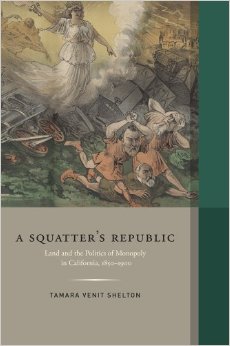 Far be it from me to try to take on such an enormous topic as liberalism in a simple blog post, but I am going to dig around the peculiar and specific roots of western liberalism while considering two excellent new books on California history. The two books are Reading for Liberalism: The Overland Monthly and the Writing of the Modern American West by Stephen J. Mexal (University of Nebraska Press: 2013) and A Squatter’s Republic: Land and the Politics of Monopoly in California, 1850-1900 by Tamara Venit Shelton (© 2013 Huntington Library, Art Collections, and Botanical Gardens and University of California Press). I’ve been teaching San Francisco history for the past few years at the SF Art Institute, and that’s given me a chance to learn a lot about the first 50 years of urban growth here. San Francisco has a remarkably short history actually, and it’s easy to think that what happened in the 19th century, while charming and often surprising, has little to do with the modern metropolis of 7+ million ringing the Bay nowadays. But echoes of those long-ago days keep reverberating against the walls of today’s City, from the wild real estate speculation that goes on much as it did in the days when this peninsula was still sand dunes and mud flats, to the deep racism and classism that white settlers brought to California and from which the state has never fully freed itself, San Francisco’s reputation for racial diversity and tolerance notwithstanding.
Far be it from me to try to take on such an enormous topic as liberalism in a simple blog post, but I am going to dig around the peculiar and specific roots of western liberalism while considering two excellent new books on California history. The two books are Reading for Liberalism: The Overland Monthly and the Writing of the Modern American West by Stephen J. Mexal (University of Nebraska Press: 2013) and A Squatter’s Republic: Land and the Politics of Monopoly in California, 1850-1900 by Tamara Venit Shelton (© 2013 Huntington Library, Art Collections, and Botanical Gardens and University of California Press). I’ve been teaching San Francisco history for the past few years at the SF Art Institute, and that’s given me a chance to learn a lot about the first 50 years of urban growth here. San Francisco has a remarkably short history actually, and it’s easy to think that what happened in the 19th century, while charming and often surprising, has little to do with the modern metropolis of 7+ million ringing the Bay nowadays. But echoes of those long-ago days keep reverberating against the walls of today’s City, from the wild real estate speculation that goes on much as it did in the days when this peninsula was still sand dunes and mud flats, to the deep racism and classism that white settlers brought to California and from which the state has never fully freed itself, San Francisco’s reputation for racial diversity and tolerance notwithstanding.
Both Mexal and Shelton are very good writers and both have done excellent jobs of delving into histories that we stopped thinking about a long time ago, if we ever did. Mexal sets out to do a combined literary, philosophical, and political analysis of the writings that appeared in San Francisco’s Overland Monthly magazine from its founding in 1868 under the editorship of Bret Harte. His goal, as his full title suggests, is to excavate the way the writings in this influential journal helped shape the self-conception of liberal republican society in the West in the post-Civil War era, an era characterized by growing industrialization and expansion of capitalist enterprises in agriculture, shipping, manufacturing, and more. Ultimately, the efforts of Overland Monthly writers are directed towards promoting development of the West at a time when the boundaries of civilization and wilderness were blurry, as were the boundaries between who qualified as members of civilized society and those who fell outside its edges. (Gray Brechin’s important Imperial San Francisco shows how Union Iron Works owner Irving M. Scott used the Overland Monthly—of which he became a director after buying a 100-year subscription—in the late 19th and early 20th century to promote an aggressive, militaristic, and imperial California—a story invisible in Mexal’s work.) For Mexal the liberal republicanism under construction in the 1860s and 1870s in California was trying to “balance the rights of the individual with the good of the public.” This is already a departure from the classical liberalism of philosopher John Locke which assumed (politically at least), as Margaret Thatcher did two centuries later, that there was no such thing as society, and that everything came down to the atomized individual.
In writing about the West in those early years, the preconceived notions of the liberal individual, the wild savage in a “state of nature,” and the emergence of the social contract that bound people to a liberal republican “deal” under a modern state were in flux. Mexal beautifully examines the short stories, travelogues, and narratives of various early Overland Monthly writers to show how they were trying to reconcile these concepts. Mexal is a sharp philosophical thinker himself. He helps frame the apparently benign self-conception of liberalism in much darker terms:
… an often overlooked characteristic of liberal selfhood…[is that it] is necessarily self-reproducing and, as a result, imperialistic. If selfhood under liberalism is equated with autonomy and autonomy is recognized as a universal moral good, then liberalism itself becomes a moral good. And if autonomy, by the same foundational liberal principles, is equated with travel, then it is good that liberal subjects cross borders to see other persons and places. But because liberalism is good, if those liberal persons see bodies they classify as not-liberal—for reasons ontological, racial, economic, or otherwise—then the same moral logic that says freedom is good also dictates that liberal subjects extend that good to other persons or spaces.
It’s difficult today to understand how so many Americans could have been so unselfconscious in the mid-19th century, accepting slavery, Indian genocide, the blatant imperial attack on Mexico in 1846 and the consequent seizure of California, and other world-historic crimes as if they were doing everyone a favor. In this analysis of liberal self-justification we start to get a glimpse of how that worked and how it was a self-reproducing logic that always put the liberal subject in the magnanimous role of “provider of civilization.” It’s not such a leap to see this process in the mid-19th century and then follow it through the annexation of Hawaii and the Philippines in the 1890s, through the dozens of military interventions in Central and South America during the 20th century, to Vietnam, Iraq, and Afghanistan (wrapping national pride in the “Good War” of WWII makes it all that much easier—even if that’s a much darker story too).
Prior to the 1868 founding of the Overland Monthly, California had already experienced two decades of often lawless, frenetic “development”—most of which involved bitter struggles over land: who would control the vast fertile and mineral-rich territory of California? The Mexican land grant holders? The Indians who lived here for thousands of years? The newly arrived Americans? The free-for-all that ensued took decades to fully sort out, and in Shelton’s A Squatter’s Republic we get a fresh look at that fraught process. The heart of liberal selfhood is private property of course, but as California gained statehood in 1849-1850, multiple and conflicting claims were made regarding its expansive lands. The early gold rush miners had simply entered river canyons, staked their claims and started panning. Law enforcement was nonexistent, as were rights for indigenous peoples or anyone deemed a “foreigner.” Mexican claims had some weight, but were frequently ignored or overrun by squatters, hence the name of her book. The squatters had a self-serving argument too:
Whiteness, landholding, and citizenship were mutually reinforcing categories that formed the foundations of the American republic in the newly acquired territories of the Far West. Land monopoly, particularly Mexican land monopoly, threatened to undermine those foundations.
For the newly arriving American settlers, small white farmers were the backbone of the American democratic system. Large landholders, especially if they weren’t white Americans, were by definition monopolists and thus enemies of democracy. With this self-righteous claim to a higher purpose than mere landgrabbing, squatters organized themselves politically and took legal and vigilante action together to enforce their self-proclaimed rights against the Californios who had been here for decades, and had legal rights to their ranches under the Treaty of Guadalupe Hidalgo that concluded the U.S.-Mexican War. Shelton’s first chapter tells the story of a then-famous riot in Sacramento over land ownership that led to several deaths after a shoot-out. James McClatchy was in the midst of the battle, and later he becomes the voice of squatters in his role as editor of the early Sacramento Bee (McClatchy newspapers are still a big chain today!). One of her great contributions is when she contests the histories that were written in the late 19th century by Josiah Royce and Bancroft’s History Factory:
The false distinction between “squatters” and “settlers” supported a narrative that began in wilderness and chaos and ended in civilization and order. By writing squatters out of history, Bancroft and Royce denied the significance of their anti-land monopolism to California’s political institutions and society. More significantly, they also naturalized consolidated, private landownership within a story about law, order, and industry in California. It would take nearly a century for historians to recover the contested nature of California’s conquest and to grapple with the long-term consequences of uncertain land rights.
Interestingly, the deeply rooted political movement against land monopolism evolved during the next decades, opposing the growing industrial monopolies as represented by the railroads (Southern Pacific in particular), ultimately shape-shifting into the pro-regulation Progressive movement at the turn of the 20th century. But along the way, it passed through various stages, one of which was the famous writings of San Francisco journalist and political philosopher Henry George. There are still proponents of George’s “single tax” on real estate even in 2014, but few probably remember his virulent anti-Chinese sentiment (typical of the 1870s in which his ideas were forged):
Not only did Henry George articulate the problems of new monopolies in an older language of agrarian reform, but he also connected land monopoly to the emerging “problem” of Chinese immigration. George feared that land monopoly, if left unchecked, would corrupt the American republic. It would crowd out small, independent producers, the backbone of democratic values, and replace them with cheap, inassimilable foreign labor… George rallied behind white workers, who felt displaced by nonwhite labor competition, and promulgated a virulent, anti-Chinese racism. To George, Chinese laborers were racially fit and culturally inclined to be tools of large-scale industrial monopoly. The presence of Chinese laborers increased monopoly’s power by lowering labor costs, raising profit margins, and enabling a few capitalists to use the profits to acquire a greater monopoly on land, the basis of production and wealth… George believed that land reform and Chinese exclusion were two necessary steps to eliminate monopoly, restore independence to small producers, and democratize opportunity in Gilded Age America. As George looked back to California’s Gold Rush history for a model of a free labor society, the squatter’s republic became the ideal for his industrial age.
The anti land monopolists, including Henry George, were ardently pro-competition. They believed that the ideal society would be made up of small independent producers, in its own way a liberal ideal that focuses on individual rights and individual initiative as the heart of society. As the industrial working class began to come into its own in the 1870s and 1880s, the politics shifted from opposing large landowners to opposing large, powerful corporations (who during that time were also large landholders). Here Shelton usefully brings in Stephen Field, the Supreme Court justice who emerged from the “squatter’s republic” of early California to shape corporate personhood with his crucial role in the local tax cases that reached the court, especially Southern Pacific vs. Santa Clara County. She situates Field’s politics in its time but shows how it was a different branch of Jacksonian Democracy:
… [Judge Stephen] Field’s political and juridical worldview connected him, not to [Senator and Democrat Stephen] White’s regulatory antimonopolists, but to an older breed of Jacksonian Democrats, who feared overweening state power. White’s antimonopolism and Field’s laissez-faire doctrine were two branches of the same Jacksonian family tree, joined by their belief in freedom of competition and contract but diverging on their understanding of how the federal government should be best protect those freedoms.
While this complicated political and legal history unfolded across the latter decades of the 19th century, literary efforts were in their own way trying to weave together the layered history of U.S. expansion with the emergent culture of the western States. This is just as important for our understanding of history, for as Mexal argues:
…history only exists because it is able to be represented as narrative. And that representation is necessarily an aesthetic act… narrative structures are first made apparent to us through the genre of fiction, and history is only coherent insofar as its constituent events are mapped onto narrative structures… Public identification, whether local or national, is formed by and through historical master narratives and political geography. But public identification also exceeds both these things…
A fascinating writer rediscovered by Mexal in his book is Noah Brooks, a regular contributor to the Overland Monthly, and a writer who didn’t enjoy the limelight like some of his contemporaries. Brooks penned a story in the journal called “The Gentleman from Reno” in which a young woman on Russian Hill in San Francisco, home alone, finds a somewhat rough-looking man knocking on her door who claims to know her (absent) husband. She lets him in and ultimately allows him to spend the night in the guest room, but suffers all the fears and doubts that bourgeois society harbored for the “wild Other,” whether savage or dark-skinned or just different. According to Mexal’s reading, Brooks is writing an allegory about how the West had scrambled the categorical truths of bourgeois society up to that time:
The right to property under liberalism is of particular interest to [Noah] Brooks, for he reframes property as a corollary of western expansion. In the story, the fear of home invasion is principally a fear engendered by western economic and geographic growth. The signifiers of fear in “The Gentleman from Reno”—western geography, masculinity, being dark-skinned—are all contained by the text’s larger theme of frontier development. In other words, the woman’s terror is both symbolic of and enabled by unchecked westward expansion. Although her apprehension is superficially oriented toward the material possessions that serve as status markers for a genteel bourgeoisie, such as the Clytie bust or the silver goblet, her fear, Brooks suggests, in fact has its origins in the shifting geopolitical landscape of a post-1848 West. By this logic, the stranger frightens the woman not because he actually poses a legitimate threat to her property but because he represents a modern, liberal West. In this new western sphere a “gentleman” actually can be dark-skinned and from Reno and not white and from Boston. The disconcertion produced by this racial and geographic transformation is what drives the emotional engine of the narrative.
But Mexal derives a more problematic conclusion from this story too: “modern liberal-republican urbanity, and its concomitant lack of a threat of bodily violence, paradoxically requires a foundation built on its opposite: a history of imperial projects to “civilize” racial others, shored up, inevitably, with violence.” In other words, the story requires no violence to evoke a palpable sense of fear in the reader on behalf of the “defenseless” young woman in her own home. But the whole history of the West to that point, rooted in genocide, racial violence, slavery, and so on, is what contextualizes this still young city environment. “Brooks’s narrativization of the ideological production of the West not only confronts a history of racial, national, and economic conquest; it also, and more significantly, frames that history as central to the emergence of modern western liberalism.”
Mexal’s book is quite an impressive effort. He has grabbed the racist essence of liberalism as it appeared in fiction and nonfiction alike in the pages of the Overland Monthly, and he won’t let go until he drives the point home:
…the fear of a heterogeneous other is at the heart of classical liberalism. It is not, however, that liberalism is overtly racist or even race aware; it is, rather that classical liberalism inadvertently replicates the logic of classical racism. In classical racism, phenotypic difference is presumed to dictate or correlate with cultural difference. Raced subjects are thus essentially savage, or at the very least possess some unchangeable cultural attribute used to justify unequal treatment… th[e] model of western cosmopolitanism is at its core assimiliationist, and, more problematically, so is the nineteenth-century model for liberalism… creating situations in which disparate subjects are able to recognize a common human nature is necessarily predicated on assimiliationist homogeneity.
He dedicates one chapter to Ina Coolbrith to analyze how her gendered existence sharply constrained her creative output; another to John Muir and his contradictory efforts to construct a “green liberalism” in the 19th century:
While there may be theoretical room for an environmentally focused liberalism, the imperialist impulse sustained by the language of wilderness complicates the practicality of that environmental liberalism. After all, even if liberal practice is not absolutely incompatible with wilderness preservation, if wilderness itself is a social construct indivisible from the logic of colonialism, then green liberalism would seem not, in fact, to be very liberal at all.
John Muir, of course, was a founder of the Sierra Club in 1892, and many say he died of a broken heart after his decade-long effort to stop San Francisco from building a dam in Yosemite’s Hetch Hetchy Valley failed in 1913. His writings exalt the wild mountains, and celebrate the opportunity to lose one’s individuality in nature. Still, he too was a thoroughly 19th century man. As the most public proponent of preservationism in its battle with conservationism, some have seen him as an early deep ecologist. But Mexal punctures that mythology thoroughly:
Even though preservationism and conservationism were framed as binary opposites, both are fundamentally anthropocentric, and it is only in their conceptions of utility that they differ. The preservation of nature and the material utility of nature are both arguments about purpose, not ideology. In both cases… nature exists for humans… An idyll of pure, wholly untouchable wilderness—the acme of preservation—would for Muir be worthless. The whole point of nature for him is that it exists for humans: so we can go out into it.
The sad truth is that if Muir had won that battle the Hetch Hetchy Valley today would have the same air pollution as Yosemite Valley, as well as the traffic, parking, and lodging issues that beset its more famous neighbor.
The land question was subsumed in the anti-monopoly politics of the early 20th century, with Teddy Roosevelt’s very public trust-busting campaigns against Rockefeller’s oil monopoly, Carnegie and JP Morgan’s steel monopolies, etc. But the deep American belief in farming and small landholders as the bedrock of Jeffersonian democracy cropped again, notably in the period just before WWI when the rising tide of revolutionary class politics struck fear in many mainstream politicians. In California, Elwood Mead, a civil engineer and irrigation specialist (who had already worked closely with the U.S. Army Corps of Engineers in major waterworks efforts) led a campaign to pass the “Land Settlement Act” of 1917, which offered financing and support for family farms in cooperative colonies, but based on individual family plots. As Shelton describes:
Concerns about the changing demographics of rural America reflected pervasive anxieties about European socialism and anarchism spreading among workers in the United States… Initially, Mead portrayed the anti-land monopolist Land Settlement Act as a conservative force to counteract radicalism in the U.S… The act’s promotional literature identified farmers as the bulwark against radical movements: “No such dangers confront government from the unrest of the farmer… He is both laborer and capitalist.”
But it wasn’t simply a conservative political effort to establish property-owning family farms, it was also an overtly racist campaign to “whiten California agriculture” at a time when politicians were stoking fears of a Japanese takeover (this despite the fact that Japanese farmers, then the largest nonwhite minority in California, were still only about 40,000 people in the whole state).
…the inherent racism of [Henry] George’s late nineteenth-century anti-land monopolism endured in the Land Settlement Act’s restrictions on eligibility. Only a “citizen of the U.S., or any person who has the intention of becoming a citizen of the United States” could apply for a farm. Japanese and other Asian immigrants, who were ineligible for naturalization, were excluded from participating in the state colonies. Mead justified their exclusion thus: “The American rural population is being displaced by an alien peasantry drawn in many sections from the Orient, or from those portions of Europe where the conditions of living are hardest.” If tenantry, and particularly foreign tenantry, remained the prevailing condition of rural life, “anything resembling an American democracy is impossible.” Mead considered the Land Settlement Act to be a crucial part of the state’s campaign against alien—and in particular, Japanese—land tenure, which lent a sense of urgency to his endeavor. He declared, “The more [state land colonies] there are, the more certain it is that rural California will in the next half century remain the frontier of the white man’s world.”
Now we’ve moved definitively into the 21st century and the white population has already fallen below half in California, and probably will be a shrinking minority as time goes on. Here in San Francisco we have a Chinese-descended Mayor for the first time in history, and five out of eleven Supervisors are of Chinese descent too. That’s pretty remarkable, not least because no one really cares or thinks it matters (the mainstream politics they represent may have a lot to do with that too), but also given the incredibly violent and racist treatment Chinese folks were subjected to for so long. And the Japanese, the Filipinos, the Mexicans and Central Americans, and African Americans, and yes, everyone who couldn’t qualify as “white.” The animosity still pops up, liberal decorum notwithstanding, though it is cloaked in hatred of the poor more than overt racism (given the racially charged maldistribution of wealth, that probably doesn’t count for much).
Anyway, much too long of a post for a blog, but wanted to air out these two interesting books and get myself back online as The Nowtopian… more to come in the weeks ahead.
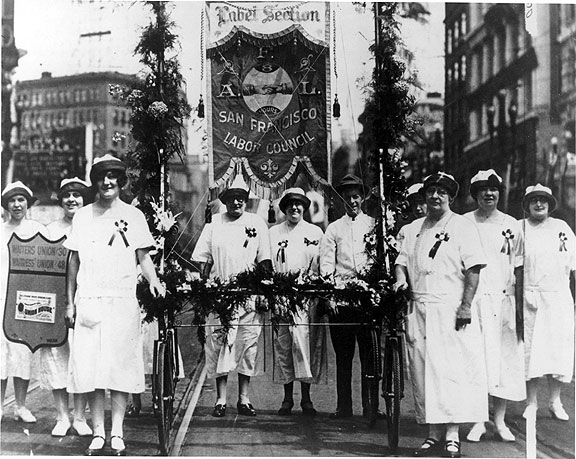
Waitress union marchers in 1925 labor day parade. Their offices were on Ellis Street in the Tenderloin.

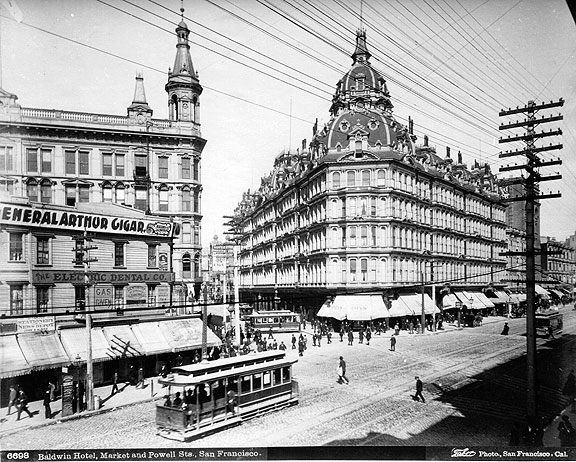

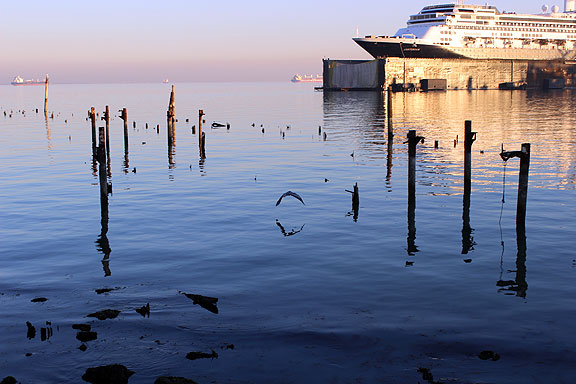
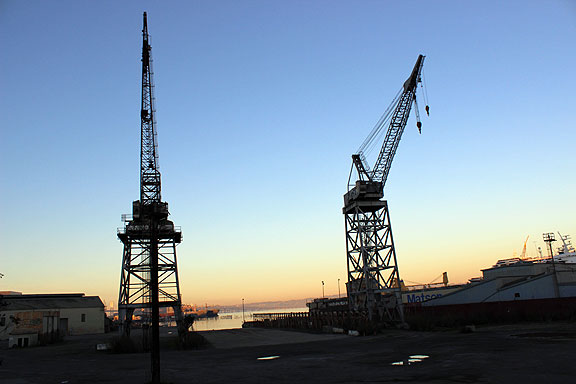
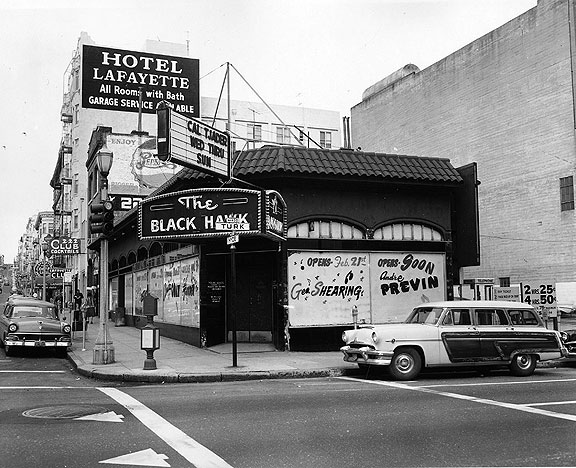











Nice piece… Just a tad there about the land battles. Bringing the SP squatters into the light was worth it, especially with that last piece on the women’s union, of which the current project is taking shape. Am currently in a rather difficult situation attempting to grok the fact that SF’s labor leaders may have intentionally destroyed the movement in fear of its growing radicalism back in 1919, and then again with 1934. Here, we find the racism, in all of its true glory. Much more is needed to understand what happened to one of the world’s most powerful labor towns. Much like the 1980’s and its direct action culture, there was a generation of San Franciscans at the turn of the last century that tried and failed. Its leadership then threw away its history rather than seek out lessons or answers to what went wrong, which they knew all too well, or so it seems. So what can we do with a broken clock in a room full of a-historic trade unionists – the folks that could have made a difference? Hey, I even found an application by a chinese butcher union in SF that applied for membership with the Labor Council around 1910. I really doubt they were accepted.
I’m living in a nice rent-controlled apartment, and thus, the tidal wave of tech-related gentrification (which could also be thought of as medical-related gentrification, or real-estate speculation-driven gentrification, or capitalism 101, or…) is most worrisome. I liked many things I’ve read lately, and thought a lot of other ones really bad. I suppose I should pen my own essay on it, but it all seems to have been said ten times over, so I balk at spending my time pontificating on it further. My partner Adriana is holding an event this Friday night “Campfire: Eviction Ghost Stories and other Housing Nightmares” in which a dozen or more people will be publicly sharing their eviction stories around a campfire next to the 24th Street BART station… we need a different system for allocating space and housing than the current system of commodified private property… I think a decent stop-gap would be a huge investment fund to allow existing tenants to buy their buildings as limited equity community land trusts, removing forever huge swaths of privately owned housing from the possibility of speculation. An even more tepid reform I would support is to amend the state Ellis Act to prevent its use until you’ve owned your property for at least 5 years, thus stopping speculators from buying a building and immediately “going out of business as a landlord” and flipping it. Meanwhile, we are counting down the time: what will come first? Our landlady dies and the building is sold out from under us to the highest bidder, who promptly evicts us? Or the bubble pops and the pressure eases so we might be able to buy it ourselves as a residential nonprofit (that we’ve set up)? Or the next quake strikes and many flee SF while prices crash? Or the Greenland ice sheets melt and the west Antarctic ice shelf cracks off and oceans rise 20 feet, flooding much of the adjoining neighborhoods? “Gentrification” is probably not going to be our main concern for very long, one way or another…
What’s the Nowtopian’s take on the Google gentrification issues?
A most engrossing post, Chris, containing much food for thought. Your historical dot-connecting is, as always, superb. I’ll definitely be adding Mexal’s and Shelton’s books to my library. Your mention of Gary Kamiya’s contribution to FoundSF reminds me that a couple of my own entries need to be updated.
Adolph Reed has a great essay about liberals in Class Notes. He bashes them, of course, that’s why it’s great!